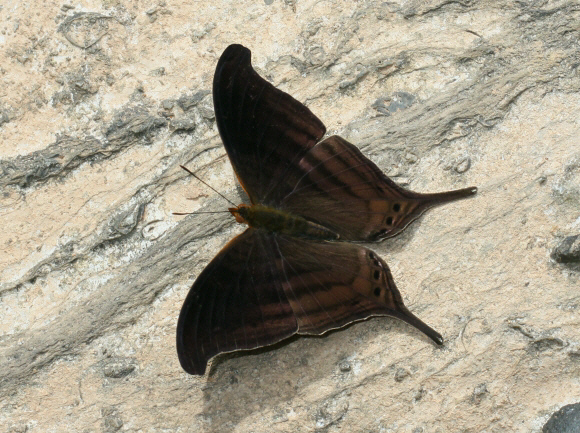 Marpesia themistocles norica, Satipo, Peru – Adrian Hoskins
Marpesia themistocles norica, Satipo, Peru – Adrian Hoskins
Introduction
The genus Marpesia is confined largely to the neotropical region, but is closely allied to the Mapwing and Maplet butterflies ( Cyrestis & Chersonesia ) of the Oriental region.
Daggerwings are similar in wing shape to Swordtails and Swallowtails ( Papilionidae ), but the latter have 6 legs whereas Marpesia and all other Nymphalidae genera have only 4 legs. Another feature to look for is the antennae. In all Papilionids these are recurved at the tip, but in Marpesia they are straight. In total there are 17 Marpesia species, all with the same wing shape as zerynthia, except for petreus which has 2 tails on each hindwing and a deeply scalloped outer margin to it’s forewing.
Marpesia themistocles can be confused with the female of M. livius, but the latter is silvery on the underside, whereas themistocles has a cryptic brown dead-leaf appearance.
Marpesia themistocles is also known by the synonym norica. The latter taxon is now classified as a subspecies of themistocles. The butterfly occurs in Venezuela, Brazil, Peru and Bolivia.
 Marpesia themistocles norica, Catarata Bayoz, Le Merced, Peru – Adrian Hoskins
Marpesia themistocles norica, Catarata Bayoz, Le Merced, Peru – Adrian Hoskins
Habitats
This is a lowland rainforest species occurring at elevations between about 100-700m.
Lifecycle
I have no data relating to themistocles, but the following characteristics are applicable in general to the genus Marpesia : The eggs are white or yellowish, and laid singly on the foliage of trees and shrubs in the family Moraceae – including Ficus, Chlorophora, Brosimum and Artocarpus. The fully grown caterpillars are very colourful, typically marked with red and / or yellow spots and stripes. There is a single row of unbranched, recurved spines along the back, and the head is adorned with a pair of very long wavy spines. They feed diurnally and rest on the upper surface of leaves. The pupae are typically pale in colour, marked with blackish spots or blotches, and have wiry filaments projecting from the back of the abdomen and from the head.
Adult behaviour
Males are usually encountered singly, or occasionally in twos and threes when visiting wet sand or mud to imbibe mineral-laden moisture. They tend to be less active than other Marpesia species, and commonly bask with wings outspread. In particularly hot weather the wings are held erect.
